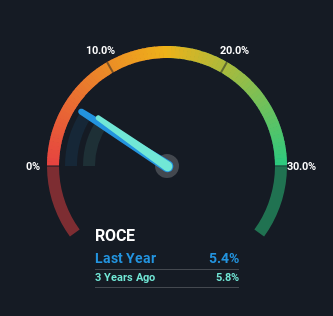PNC Process Systems (SHSE:603690) Is Reinvesting At Lower Rates Of Return
What trends should we look for it we want to identify stocks that can multiply in value over the long term? Typically, we'll want to notice a trend of growing return on capital employed (ROCE) and alongside that, an expanding base of capital employed. If you see this, it typically means it's a company with a great business model and plenty of profitable reinvestment opportunities. Although, when we looked at PNC Process Systems (SHSE:603690), it didn't seem to tick all of these boxes.
Return On Capital Employed (ROCE): What Is It?
For those that aren't sure what ROCE is, it measures the amount of pre-tax profits a company can generate from the capital employed in its business. To calculate this metric for PNC Process Systems, this is the formula:
Return on Capital Employed = Earnings Before Interest and Tax (EBIT) ÷ (Total Assets - Current Liabilities)
0.054 = CN¥365m ÷ (CN¥12b - CN¥5.0b) (Based on the trailing twelve months to September 2023).
Therefore, PNC Process Systems has an ROCE of 5.4%. On its own, that's a low figure but it's around the 6.0% average generated by the Machinery industry.
Check out our latest analysis for PNC Process Systems

Above you can see how the current ROCE for PNC Process Systems compares to its prior returns on capital, but there's only so much you can tell from the past. If you'd like, you can check out the forecasts from the analysts covering PNC Process Systems for free.
How Are Returns Trending?
Unfortunately, the trend isn't great with ROCE falling from 12% five years ago, while capital employed has grown 1,229%. Usually this isn't ideal, but given PNC Process Systems conducted a capital raising before their most recent earnings announcement, that would've likely contributed, at least partially, to the increased capital employed figure. It's unlikely that all of the funds raised have been put to work yet, so as a consequence PNC Process Systems might not have received a full period of earnings contribution from it. It's also worth noting the company's latest EBIT figure is within 10% of the previous year, so it's fair to assign the ROCE drop largely to the capital raise.
On a side note, PNC Process Systems has done well to pay down its current liabilities to 42% of total assets. So we could link some of this to the decrease in ROCE. Effectively this means their suppliers or short-term creditors are funding less of the business, which reduces some elements of risk. Since the business is basically funding more of its operations with it's own money, you could argue this has made the business less efficient at generating ROCE. Either way, they're still at a pretty high level, so we'd like to see them fall further if possible.
The Bottom Line On PNC Process Systems' ROCE
Even though returns on capital have fallen in the short term, we find it promising that revenue and capital employed have both increased for PNC Process Systems. Furthermore the stock has climbed 45% over the last five years, it would appear that investors are upbeat about the future. So while the underlying trends could already be accounted for by investors, we still think this stock is worth looking into further.
On a separate note, we've found 2 warning signs for PNC Process Systems you'll probably want to know about.
While PNC Process Systems isn't earning the highest return, check out this free list of companies that are earning high returns on equity with solid balance sheets.
New: Manage All Your Stock Portfolios in One Place
We've created the ultimate portfolio companion for stock investors, and it's free.
• Connect an unlimited number of Portfolios and see your total in one currency
• Be alerted to new Warning Signs or Risks via email or mobile
• Track the Fair Value of your stocks
Have feedback on this article? Concerned about the content? Get in touch with us directly. Alternatively, email editorial-team (at) simplywallst.com.
This article by Simply Wall St is general in nature. We provide commentary based on historical data and analyst forecasts only using an unbiased methodology and our articles are not intended to be financial advice. It does not constitute a recommendation to buy or sell any stock, and does not take account of your objectives, or your financial situation. We aim to bring you long-term focused analysis driven by fundamental data. Note that our analysis may not factor in the latest price-sensitive company announcements or qualitative material. Simply Wall St has no position in any stocks mentioned.
About SHSE:603690
PNC Process Systems
Researches, develops, produces, and sells semiconductor process equipment, system integration and support equipment, and electronic materials in China and internationally.
High growth potential and fair value.
Market Insights
Community Narratives




